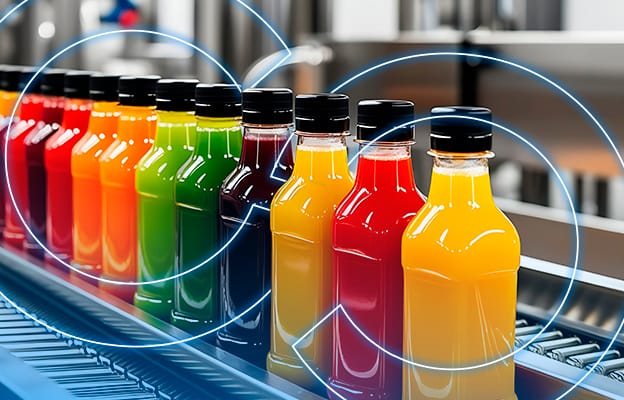How Manufacturers Can Reformulate Food and Beverage Products After Dye Bans

When the U.S. Food and Drug Administration banned red dye 3, also known as FD&C Red No. 3 or erythrosine, in January 2025, food and beverage manufacturers were given a two-year window to reformulate any products that contain the now banned substance.
That might seem like a generous timeframe, but reformulating products is a complex, multifaceted process that can often take more than two years to finalize. For companies that operate on slim margins, it can also represent a serious financial challenge.
The ban on red dye 3, an ingredient known to cause cancer in lab rats, but doesn’t show the same effect in humans, is part of a larger trend toward cleaner and stricter expectations for food products in the U.S.
Despite these challenges, private label manufacturers are well-positioned to succeed. Leaner product development cycles and generally lower overhead involved in advertising and branding means these manufacturers can pivot into future-forward products quicker than more slow-moving organizations.
For food and beverage manufacturers looking to reformulate before the January 15, 2027 deadline, a successful pivot begins with effective tracking of data and compliance factors and it’s easiest when that framework occurs on a “single source of truth” platform.
Understanding the Red Dye 3 Ban
The FDA’s decision to ban FD&C Red No. 3 marks a watershed moment for food safety regulation in the United States.
This synthetic petroleum-based dye has long been used in candies, snacks, baked goods and beverages to deliver a vibrant red color. While its use in cosmetics was prohibited in 1990, it remained in the food supply until now.
Following decades of mounting scientific evidence and pressure from consumer advocacy groups, the FDA formally revoked its approval, citing carcinogenicity in animal studies under the Delaney Clause of the FD&C Act.
The dye has been banned for years in other parts of the world, including China, Japan, United Kingdom, Australia and the European Union.
For private label manufacturers, the implications of the ban are immediate and far-reaching. Manufacturers have until January 15, 2027, to remove Red No. 3 from all food products and they aren’t just navigating FDA mandates.
The California Food Safety Act (AB 418), which also bans Red No. 3, goes into effect on the same date, with other states considering similar legislation. Add to this the increasing demand from national retailers for clean-label products and reformulation becomes not just a compliance issue, but a competitive one.
Products at highest risk of disruption include:
- Fruit-flavored cereals, candies and snack bars
- Maraschino cherries and preserved fruits
- Frostings, icing and baking mixes
- Beverages like pink lemonades and strawberry milks
Interestingly, private label goods often make up a significant share of shelf space in key categories like kids’ snacks and confections, categories where Red No. 3 is frequently found and where consumer expectations around safety are highest.
For forward-looking manufacturers, the ban is an obstacle and an opportunity: it’s a chance to create products that can improve category leadership and build trust through clean, compliant and transparent formulations.
The Challenges of Product Reformulation
Reformulating products to eliminate Red Dye No. 3 and other recently banned additives is a complex, resource-intensive process that requires coordination across multiple teams.
Food and beverage manufacturers must balance product integrity with evolving compliance standards, all while meeting consumer expectations for flavor, appearance and price. The urgency to reformulate is clear, but executing it efficiently demands both strategic foresight and operational agility.
Most synthetic dyes are popular not just for their vibrant hues but also for their stability, consistency and low cost. Replacing them involves more than swapping one ingredient for another. Natural alternatives, such as beet powder, anthocyanins, spirulina or turmeric, come with their own set of challenges, particularly around stability, sourcing and sensory impact.
These ingredients can shift the flavor profile, behave differently during processing or degrade under certain storage conditions. Product teams need time to test and validate performance before any go-to-market decisions.
Key reformulation challenges include:
- Color Matching and Visual Appeal: Synthetic dyes offer highly controlled, vivid pigmentation. Natural colorants may vary from batch to batch, affecting shelf consistency.
- Flavor Compatibility: Some alternatives introduce off-notes or alter taste subtly, requiring additional flavor balancing.
- Shelf Life and Stability: Natural ingredients may shorten shelf life or require revised packaging strategies to prevent degradation.
- Cost and Sourcing: Reformulated products often involve more expensive inputs and new supplier relationships, increasing procurement complexity.
- Regulatory and Labeling Updates: Ingredient changes trigger new compliance checks, updated nutritional labels and packaging redesigns across every sales channel.
Reformulation when attempted for any reason also carries risk.
Without structured processes and clear visibility into formulation data, manufacturers may run into delays, cost overruns or inconsistent quality. Teams must document each step, evaluate ingredient-level compliance and align packaging, marketing and regulatory functions early in the process.
Digital platforms like product lifecycle management (PLM) tools can streamline this work by centralizing formulation data, enabling real-time collaboration and supporting scenario planning for R&D teams.
Successful reformulation requires more than compliance, it requires systems that allow teams to move decisively, stay aligned and deliver consistent results at scale.
How Private Label Manufacturers Can Lead the Way
Private label manufacturers have a distinct opportunity to lead reformulation efforts and capture market share in a changing regulatory environment.
Their streamlined organizational structures and closer alignment with grocery retailers’ priorities allow them to act quickly, test new formulations at scale and respond directly to consumer demand for clean-label products.
As the industry shifts toward transparency and additive-free formulations, private label manufacturers can position themselves as first movers in the dye-free transition.
Product development teams working on private label lines benefit from shorter innovation cycles, direct retail integration and the ability to test and launch SKUs faster than many legacy manufacturers.
This agility makes it possible to pilot reformulated versions of high-volume products and iterate rapidly based on market feedback. Retailers are also increasingly prioritizing vendors who bring proactive solutions, not reactive adjustments.
To lead reformulation efficiently, private label manufacturers can:
- Embed ingredient transparency across product lines using a centralized system that tracks specifications, sourcing and compliance data.
- Align closely with regulatory teams to monitor updates and ensure early awareness of ingredient restrictions at the federal and state level.
- Use PLM technology to manage complexity, from version control and cross-functional collaboration to packaging updates and vendor communication.
- Treat reformulation as a consumer engagement opportunity, highlighting dye-free, cleaner ingredient lists in packaging and marketing strategies.
- Evaluate supplier readiness by assessing whether partners can meet clean-label sourcing standards and documentation requirements.
Private label success in this space depends on digital tools that bring speed, structure and visibility to product reformulation. PLM platforms enable private label teams to work with precision, collaborate seamlessly with suppliers and reduce risk across the development lifecycle.
By investing in systems and processes that support agile innovation, private label manufacturers can define what safety, trust and consumer relevance look like in the post–Red Dye 3 marketplace.
A Roadmap for Reformulation Success
Reformulating to remove Red Dye No. 3 and other restricted additives requires more than ingredient swaps. Food and beverage manufacturers need a structured, scalable approach to manage product changes across their entire portfolio.
A clear roadmap helps teams reduce delays, ensure compliance and maintain brand integrity during transition periods. Strategic alignment between R&D, supply chain, compliance and marketing is essential for success.
Leading companies treat reformulation as a product lifecycle challenge. They use digital infrastructure to connect the right data, teams and decisions across every step.
With regulatory timelines now set, the most prepared organizations are executing against standardized reformulation frameworks.
Here is a proven roadmap to guide the process from a high level.
- Audit your portfolio: Start by identifying all SKUs containing banned or high-risk ingredients. Use product data systems to generate a clear list by category, sales volume and regulatory risk.
- Evaluate supplier capabilities: Work with current and prospective suppliers to identify clean-label replacements. Request updated spec sheets, allergen information and compliance certifications.
- Run formulation trials: Collaborate with R&D to test substitute ingredients for taste, stability, appearance and scalability. Document all test results and link them to product records.
- Update labels and packaging: Ensure all reformulated SKUs meet federal, state and retailer labeling requirements. Coordinate timelines for packaging changes and shelf rollouts.
- Train internal teams and partners: Align marketing, sales and regulatory teams around the changes. Equip them with the data and messaging needed for retailer and consumer communication.
Each step in the roadmap benefits from centralized product data and real-time collaboration tools. Teams can make decisions faster, ensure compliance at every stage and reduce risks tied to late-stage changes.
A structured reformulation process not only ensures regulatory readiness but also strengthens a brand’s reputation for safety, transparency and innovation.
How PLM Can Help Food and Beverage Manufacturers Adapt
The ban on Red Dye No. 3 is a clear signal to manufacturers that moving forward, they must be able to pivot and reformulate efficiently, whether it’s because of regulations, supply chain disruptions or changing consumer needs.
Regulatory shifts are becoming more frequent and consumer expectations for transparency continue to rise. Product lifecycle management platforms provide the foundation to navigate this evolving landscape with speed and confidence.
PLM technology centralizes product data across departments and geographies. It enables teams to track every aspect of a product’s lifecycle, from ingredient sourcing to packaging updates to regulatory documentation. By making formulation, compliance and labeling data accessible in real time, PLM reduces risk and accelerates decision-making.
Forward-looking manufacturers use PLM to build agility into their product development processes.
They can model multiple reformulation scenarios, test ingredient substitutions virtually and align packaging timelines with formulation changes, all from a single digital hub.
Key PLM capabilities that support regulatory readiness include:
- Centralized ingredient and allergen data for faster audits and reporting
- Automated compliance monitoring across multiple regions and regulatory bodies
- Scenario planning tools to model cost, nutrition and sustainability tradeoffs
- Real-time supplier collaboration to validate inputs and specifications
- Version control and workflow automation for efficient cross-functional execution
Centric PLM™ is a platform that enables private label manufacturers to manage reformulation initiatives with precision.
The platform supports rapid response to changing regulations and integrates seamlessly with existing systems to improve visibility and collaboration across teams.
As food safety regulations become more dynamic, PLM will play a critical role in long-term business resilience. Teams that adopt robust digital infrastructure now will be better prepared to handle future ingredient bans, shifts in consumer demand and emerging retailer requirements.
The next wave of regulatory change is already taking shape.
Turn Reformulation Into Competitive Advantage
From synthetic dye bans to evolving clean-label standards, private label food and beverage manufacturers must be ready to respond to shifting regulations, retailer requirements and consumer expectations at any moment.
The most prepared organizations are not relying on spreadsheets or siloed systems. They’re building connected ecosystems where teams, suppliers and data operate in sync.
A modern, all-in-one platform like Centric PLM brings structure, speed and visibility to the entire product lifecycle, from early R&D through reformulation, labeling and launch.
Private label manufacturers that adopt centralized digital infrastructure are better positioned to manage ingredient transparency, navigate compliance and stay aligned across functions. They make decisions faster, avoid costly delays and turn regulatory pivots into opportunities to lead.
The next reformulation challenge is already on the horizon. Manufacturers that embrace unified product data, agile workflows and collaborative platforms will be ready, not just to react, but to grow.








